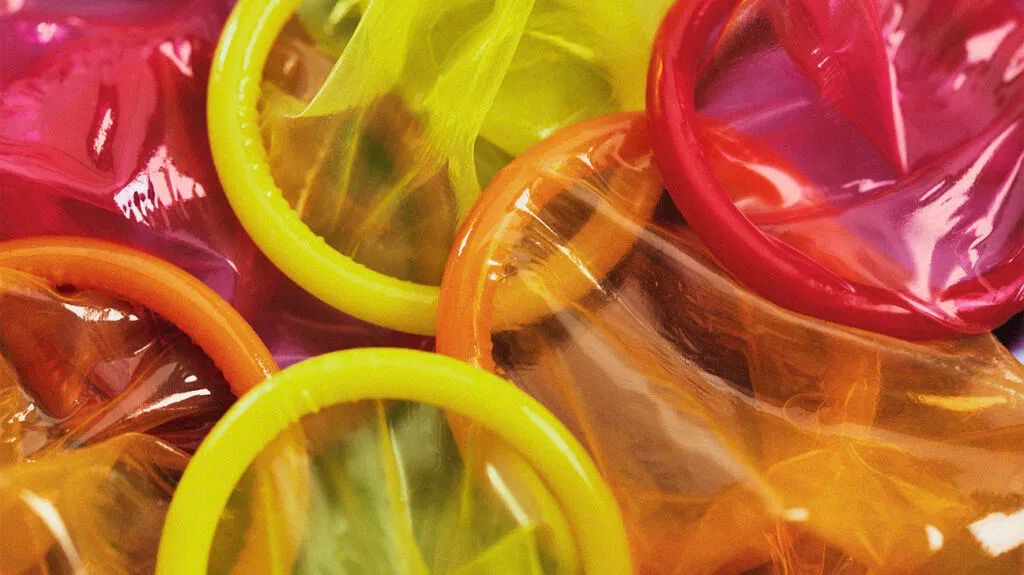Sexual Health
Condoms, Dental Dams & Lube
Condoms
Condoms are one of the oldest birth control methods. People have been using condoms for contraception, decoration, and enhanced pleasure for hundreds of thousands of years. With so many condom options today, they are in the top three methods of contraception used by American women, and the number one method of contraception used by American teens.
EFFECTIVENESS: Used correctly, male condoms offer up to 98% effectiveness against pregnancy. With typical use, male condoms are about 85% effective against pregnancy. The female condom is about 95% effective at preventing pregnancy when used correctly, and about 79% effective with typical use.
They also offer a reduced risk of some STIs such as Chlamydia, gonorrhea and HIV; others (like herpes, HPV and syphilis) can still be transmitted even if a condom is used correctly. This is because these STIs are transmitted by skin to skin contact, and the condom may not cover the infected area.
Condoms can be used for oral sex, with toys, and as an extra barrier method for STI protection even when not having penetrative sex.
SIDE EFFECTS: There are no long term side effects to condoms, but people may be allergic to latex, spermicide, and certain types of lube. People with allergies can use different types of condoms, or their own hypo-allergenic lube.
BENEFITS: Condoms are a non-hormonal method of birth control that can be used only when necessary. Both partners can buy and carry condoms, and condoms prevent against most STIs.
Beyond their use for contraception and STI prevention, condoms have all sorts of advantages.
Some condom designs are just plain fun and can add some extra spice into the moment. Condoms come in different colors, patterns, flavors and some even glow in the dark. With climax control, mentholated and warming condoms, they can add that extra bit of sensation, or make sure that things aren’t too sensitive.
Condoms help many men have longer lasting sex. They can also make cleanup after sex easier, and changing condoms between anal and vaginal sex can help prevent UTIs.
TYPES: There are so many types of condoms that even for people who don’t necessarily love the first condom they use, there could be a perfect fit yet to find. And for a lot of couples, the exploration in trying out new condoms can be half the fun.
Male/Female (what is a female condom?)
Both male and female condoms are believed to date back to the ancient Egyptians, even though female condoms have been more recently FDA approved and marketed in the US.
Don’t be deceived by the name, female condoms are not just for the ladies. They were originally designed to work as anal condoms, and are just as effective in STI protection when used anally.
The female condom consists of a two plastic rings at both sides of a poly urethane sheath or pouch. Once the female condom is placed inside of the vagina or anus, the ring at the closed end helps to keep the condom in place, while the ring at the open end acts as a guide outside of the vulva or resting above the anus. This allows for a slightly more “roomy” feel than the male condom.
The female condom also allows for a feeling of spontaneity, as the female condom can be put in place up to 8 hours before use, avoiding having to stop and put it on directly before intercourse.
Warning: it is actually less effective to double up protection. Wearing a male condom with a female condom makes both barriers more likely to break from the friction of the two rubbing together.
Materials: What Are Condoms Made Of?
The three main materials for condoms – latex, polyurethane and organic (lambskin) – all help prevent pregnancy. However organic condoms do not protect against sexually transmited infections (STI).
Latex condoms are the most common and generally least expensive condom option. Latex can easily stretch without breaking, allowing these condoms to better fit the individual and preventing tears and breaks. An estimated 4% of the population is allergic or sensitive to latex, and should not use latex condoms. Also, most types of latex are made with a milk protein, and are therefore not considered vegan.
Polyurethane condoms are an excellent alternative to latex. Polyurethane does not have as much give as latex, so these condoms may have a slightly more loose fit, instead of forming to the penis. However, polyurethane is still an incredibly strong material, allowing polyurethane condoms to be thinner than latex condoms. Polyurethane is also more heat conductive, which for some people can create the illusion of not wearing a condom (we perceive moisture by changes in heat). A down side, though, is that polyurethane can make a crinkling noise unlike its silent counterparts. Most female condoms are made out of polyurethane or similar non-latex materials.
Organic, or lambskin, condoms are generally made from a portion of sheep intestinal lining. While more expensive, some people find lambskin condoms to feel more natural and to better transmit heat. Lambskin condoms are also biodegradable. Unlike other materials, organic condoms do not prevent against STIs, as they are porous enough to let viruses through but not sperm.
Shapes and Sizes
Condoms come in different shapes, lengths, girths, thicknesses, and textures. This is not just the difference between the marked sizes of standard and XXL, but there are also slight variations in condom size from brand to brand. Latex condoms also will stretch to fit most men, so sizing is more about what is comfortable and works for you. Beyond length and girth, condoms also range in shape.
Some lines such as Pleasure Plus have greatly flared heads, to allow for a looser more natural feel, some gently taper, and some provide a snug fit for both head and shaft. The thickness and texture of a condom can also contribute to its fit.
Condoms range in sheerness by type and brand, and they can come ribbed, studded, and in almost any texture you can think of for his, her, and your pleasure.
How To Use Condoms Correctly
Using condoms correctly greatly improves their effectiveness (up to 98%), so here is a quick how to for the male condom.
Condoms shouldn’t be stored somewhere too warm or somewhere where they could freeze. This means that your bedside table is better than your back pocket. Also, the friction of a wallet or a tight storage space can rub against condoms in their packaging, and progressively wear them away.
Condoms can expire, so check the expiration date printed on the packaging.
When opening a condom be careful not to tear at it. This seems like a common sense step, but in the heat of the moment, remember to push the condom aside in the packaging if you are going to open it with your teeth.
Now that you have condom in hand, you want it to look like a sombrero, with the tip pointing out and the rest ready to roll down (if you get this step backwards it won’t roll on). At this point, just a drop or two of lube in the tip can make all of the difference.
Pinch the tip, and roll the rest down. You want to pinch the tip to leave some space to catch ejaculate. If you are putting on a condom with your mouth you can pinch the tip between your lower lip and the gums below your front teeth, or with the tip of your tongue and the roof of your mouth.
Then briefly admire your work, making sure that everything is rolled all the way down and in place, and you are good to go!
Dental Dams
Dental dams are not technically birth control, as they are not used to prevent pregnancy, but they do prevent against STIs.
A dental dam is a thin sheet of latex or polyurethane placed over the vulva or anus generally for oral sex to prevent the spread of STIs, and to give partners a barrier. You can buy dental dams, or you can make them yourself by cutting the tip off of a condom and then cutting down the shaft, leaving a square of latex or polyurethane.
Some types of saran wrap can also be used as dental dams, although the microwave safe verities are not effective in the prevention of STIs.
Once you have a dental dam, you can apply lube and then simply hold it over the vulva or anus before performing oral sex.
Lube
Lube is one of the easiest additions to sex to make everything go a little more smoothly. While lube can help women with low self lubrication, many individuals and couples that thought they never had a problem in the bedroom realize that lube can just make the great even better.
Lube can make condoms more natural feeling and less likely to break, can make sex more comfortable, and makes anal sex safer and more enjoyable (unlike the vagina, the anus is not a self lubricating organ) and can also be applied to sex toys to make them glide more smoothly.
The three most common types of lube are water based, silicon based, and oil based each with its own set of advantages and disadvantages.
Despite the generalizations about the differences between the three types of lube, there can be just as much variation within the categories. Some long lasting water based lubes can feel even thicker and slicker than silicone, while some silicone based lubes are as light and natural feeling as water.
Lube Types
Water Based
Water based lubes can range in feeling from resembling natural female lubrication, to a much thicker or silkier lube.
Many people looking for hypoallergenic or non-irritating lubes use water base, as these lubes can have the most basic of ingredients and are absorbed into the skin instead of remaining on the surface of the skin as potential irritants until they are washed off.
Because the water component of water based lubes can be absorbed into the skin, these lubes are not as long lasting as silicone or oil based lube, but to revive a water based lube it is possible to just add a little bit water instead of reapplying lube.
The water will combine with the other ingredients, and you will feel as if you had just reapplied the lube itself (this is one of the best money and lube saving tricks).
Water based lubes are also great because they are almost always compatible with condoms and toys, and unlike oil and silicone, they won’t stain your sheets.
There are so many lubes on the market, finding the right one can be a long and fun process. These are just a few suggestions showing the broad range of water based lubes:
- For light, natural and hypoallergenic: H2O Sliquid, Pink (packaged as Gun Oil for men)
- For something slightly thicker or silkier: Maximums, Liquid Silk
- For the thickest: Probe
Silicon Based
Unlike water based lube, silicone based lubes will stay on the surface of the skin without evaporating or being absorbed, this leads to a longer lasting lube.
Silicone lubes are also often slicker than water based lubes. While silicone lubes are condom safe, they are not always safe to use with toys.
As a general rule, silicone lubes can break down silicone toys (although some toys made with less porous silicone can debatably handle silicone lube if washed after use).
It’s also important to note that many silicone lubes can stain your sheets.
Some examples:
- ID Millennium or for extra long lasting ID Velvet (formerly ID Platinum)
- For a highly concentrated lube, Pjur (formerly Mr. Eros)
Oil Based
Oil based lubes come with two huge warnings—they are NOT compatible with latex condoms or toys (they are often compatible with silicone toys), and they may cause yeast infections and UTIs in women.
That said, these lubes provide a long lasting texture and feel that Silicon and Water based lubes can’t quite mimic. Oil based lubes can also stain your sheets.
Some examples:
- Valera
- Anal Lube
More Options
Lubes of all types also come in different flavors, scents/odorless, warming/cooling, and in a wide array of bottles tubes and pouches. There are even stimulating and climax control lubes. These variations can have a huge effect on whether or not a lube works for a person or couple. For example, even if a lube is the right consistency, the bad taste of an unflavored lube might be a turn off, or the easy to use bottle of a lube might make all the difference.
Some Lube Tips
Recently, lube companies started marketing “his and hers” lube sets. These lubes capitalize on the science behind lube types. Water will bead up and not absorb into silicone, much like an oil and water effect. This means that if you use both silicone and water based lubes together, the sliding of the lubes (water on silicone) creates an extra slick experience.
Generally, the “her” lube is a silicone base with a slight tingle (warming or cooling for some extra stimulation) while the “his” lube is water based.
Even if you are not in a “his and hers” situation, you can use your own silicone and water based lubes together for a scientifically slick experience at half the coast of the packaged sets.
Unlike condoms, most lube can handle temperature changes in storage. This means that you can keep lube on a heater during the winter, or in the fridge or by your AC during the summer.
Warm lube can feel a little more natural, while cold lube can provide that extra sensation during the hot summer. Some oil based lubes are even meant to be heated up by placing the bottle in hot water.
Although, this does not mean that you can freeze or boil your lube and expect it to still work, just a little bit of temperature change goes a long way.
If you are looking for a more natural feeling lube, you can add water to water based lubes to thin them out, or make them last longer. Even adding a little bit of water instead of reapplying lube during use can revive the slick feeling of lube already on your body.









